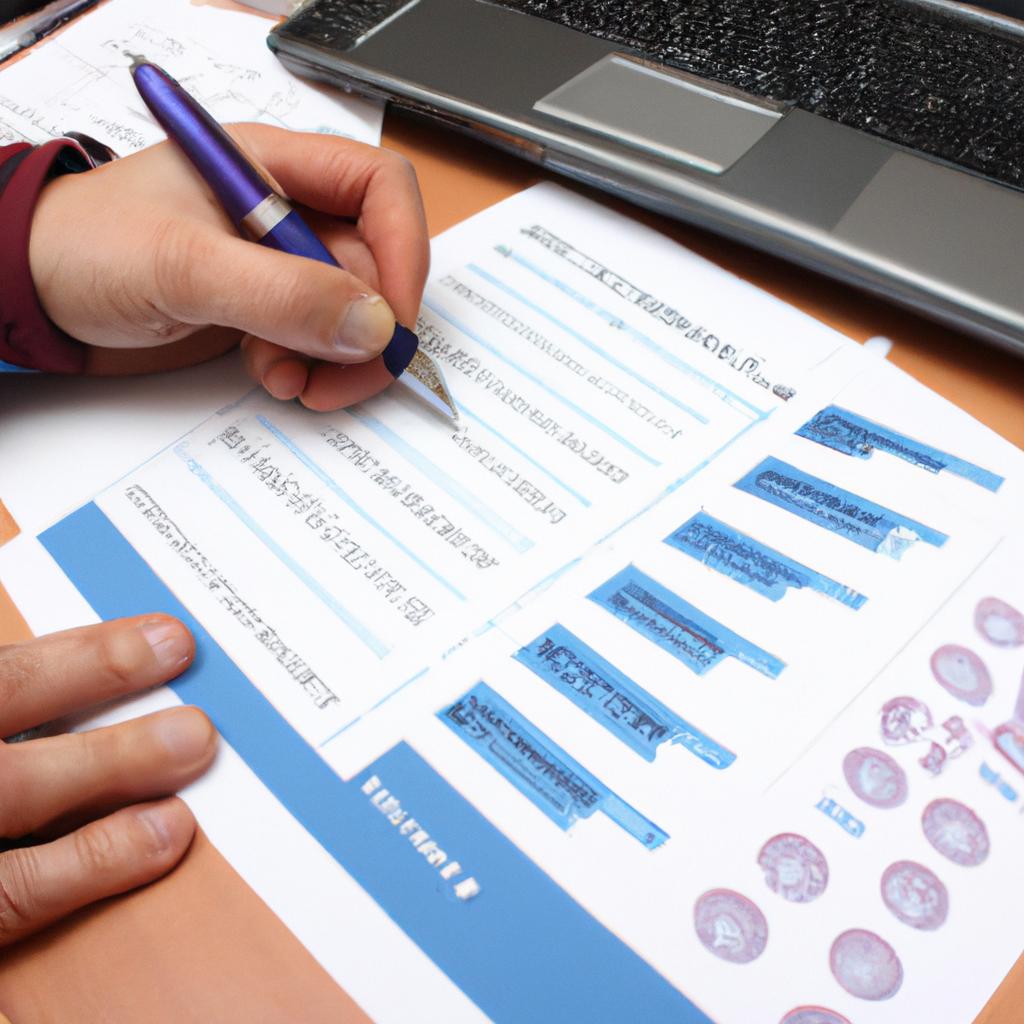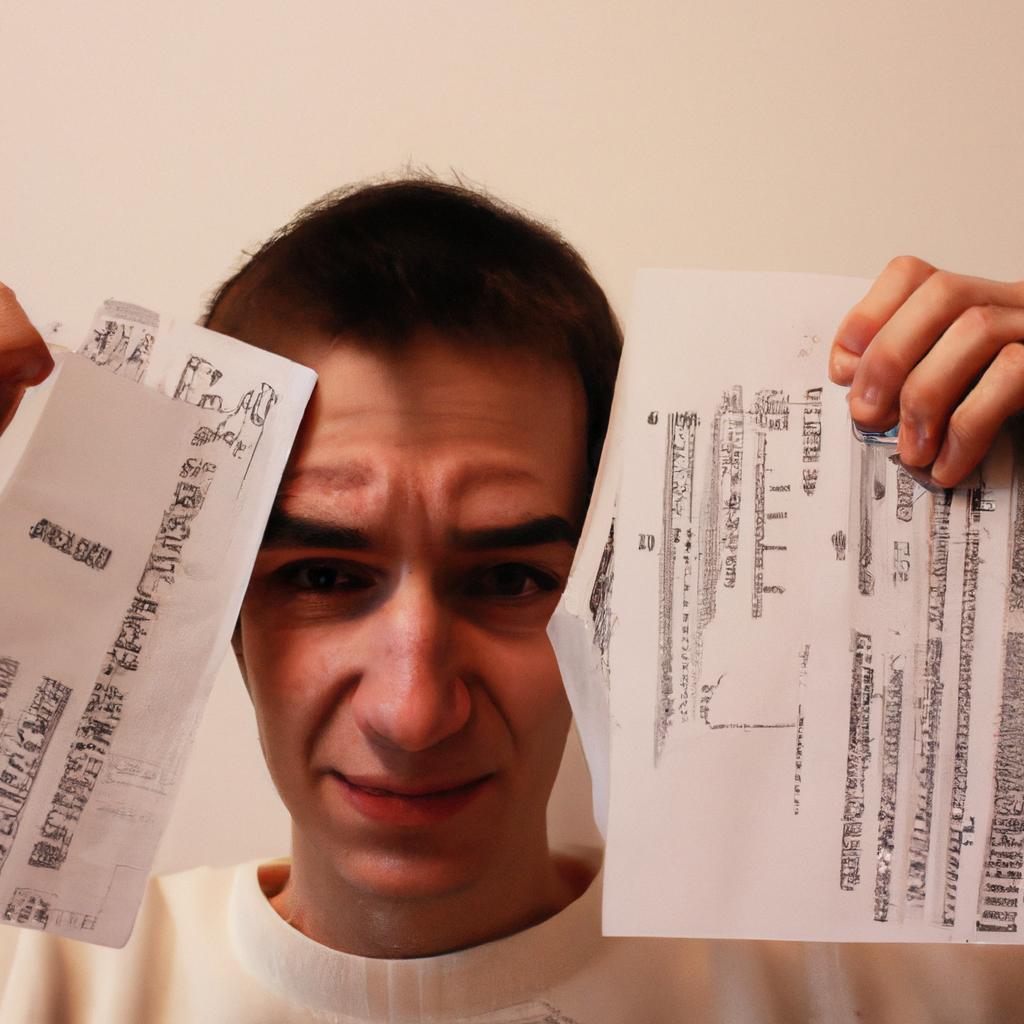Claims Processing in Body Myositis: Medical Finance

Claims processing in body myositis is a crucial aspect of medical finance that ensures timely reimbursement for healthcare services rendered to patients suffering from this debilitating autoimmune disorder. With the rising incidence of body myositis, efficient claims processing has become increasingly important to facilitate accurate billing and mitigate financial burdens on both patients and healthcare providers. To illustrate the significance of this topic, consider a hypothetical case study where a patient diagnosed with body myositis requires ongoing treatments and specialized care. In such scenarios, proper claims processing becomes paramount as it enables healthcare professionals to obtain necessary funds for optimal management of the patient’s condition.
Efficient claims processing holds significant implications for both patients and healthcare providers involved in treating individuals affected by body myositis. From the perspective of patients, streamlined claims processing ensures they receive appropriate reimbursements without undue delays or complications. This allows them to focus on their treatment and recovery rather than being burdened with excessive out-of-pocket expenses. Moreover, prompt claim settlements also contribute to reducing financial stress among patients, enabling better access to comprehensive care options tailored specifically to address the complexities associated with body myositis.
On the other hand, healthcare providers benefit from effective claims processing through improved cash flow management. Timely payments ensure a steady revenue stream that supports continued provision of quality care to body myositis patients. It allows healthcare providers to invest in necessary resources and technologies, such as specialized equipment and medications, which are crucial for managing this autoimmune disorder effectively. Additionally, efficient claims processing reduces administrative burdens on healthcare professionals, enabling them to focus more on patient care rather than dealing with complicated billing procedures or claim denials.
To achieve successful claims processing in body myositis cases, several key factors should be considered. Firstly, accurate documentation of all medical services provided is essential. This includes detailed records of consultations, diagnostic tests, medications administered, and any other relevant treatments or procedures performed. Thorough documentation helps ensure that claims are properly coded and submitted for reimbursement accurately.
Secondly, healthcare providers need to have a clear understanding of the insurance policies and coverage options available to their body myositis patients. This involves verifying eligibility, understanding pre-authorization requirements, and staying up-to-date with changes in reimbursement guidelines or coding practices.
Thirdly, effective communication between healthcare providers and insurance companies plays a critical role in timely claims processing. Open lines of communication allow for clarification or resolution of any discrepancies or issues that may arise during the claims submission process.
Lastly, leveraging technology solutions can greatly enhance claims processing efficiency. Electronic health record (EHR) systems integrated with billing software can streamline the entire process by automating tasks such as claim generation and submission. Using electronic platforms also facilitates faster communication between healthcare providers and insurance companies, reducing delays caused by manual paperwork.
In conclusion, efficient claims processing is vital for ensuring timely reimbursement and financial stability in the treatment of body myositis patients. It benefits both patients and healthcare providers by minimizing financial burdens and facilitating optimal management of this debilitating autoimmune disorder. By adhering to proper documentation practices, understanding insurance policies, maintaining open communication channels with insurers, and utilizing technology solutions where possible, healthcare professionals can improve their ability to navigate the complex world of medical finance related to body myositis.
Understanding Body Myositis: Causes and Symptoms
Body myositis is a rare autoimmune disease that affects the muscles, resulting in muscle weakness and inflammation. While the exact cause of body myositis is unknown, researchers believe it may be triggered by a combination of genetic and environmental factors. One example illustrating the impact of this condition is Sarah, a 45-year-old woman who started experiencing progressive muscle weakness in her limbs. As her symptoms worsened over time, she sought medical help and was eventually diagnosed with body myositis.
To better understand body myositis, let’s explore its causes and symptoms:
Causes:
- Genetic predisposition: Some individuals may have inherited certain genes that make them more susceptible to developing body myositis.
- Environmental triggers: Exposure to certain viruses or toxins could potentially trigger an immune response leading to the development of the disease.
- Abnormal immune response: In people with body myositis, their immune system mistakenly attacks healthy muscle tissue, causing inflammation and damage.
- Autoimmune conditions: Research suggests that there might be a link between body myositis and other autoimmune diseases such as lupus or rheumatoid arthritis.
Symptoms:
- Muscle weakness: The hallmark symptom of body myositis is progressive muscle weakness, often starting in the proximal muscles (those located closest to the trunk). This can lead to difficulties with everyday activities like walking, climbing stairs, or lifting objects.
- Fatigue: Many individuals with body myositis experience persistent fatigue even after minimal physical exertion due to ongoing inflammation within their muscles.
- Joint pain and stiffness: Some patients may also experience joint pain and stiffness alongside muscle weakness.
- Dysphagia: In severe cases, swallowing difficulties (dysphagia) may occur due to weakened throat muscles involved in swallowing.
Table – Emotional Impact on Individuals Living with Body Myositis:
| Emotion | Impact |
|---|---|
| Frustration | Struggling with day-to-day activities |
| Anxiety | Uncertainty about the disease’s progression |
| Isolation | Difficulty participating in social events |
| Depression | Dealing with chronic pain and limitations |
Understanding the causes and symptoms of body myositis is crucial for early detection and effective management.
Diagnosing Body Myositis: Tests and Procedures
Claims Processing in Body Myositis: Medical Finance
Understanding the causes and symptoms of body myositis provides a crucial foundation for effective diagnosis and treatment. Now, let us delve into the intricacies of claims processing associated with this debilitating condition. To illustrate the challenges individuals face, consider the hypothetical case of Sarah, a 35-year-old woman diagnosed with body myositis.
Sarah’s journey begins when she seeks medical attention due to muscle weakness and fatigue. After numerous tests and consultations with specialists, she finally receives a confirmed diagnosis of body myositis. This opens up a complex process of navigating medical finance systems to ensure proper reimbursement for her treatments.
Navigating the world of medical finance can be overwhelming for patients like Sarah. Here are some key points to consider:
- Insurance Coverage: Patients must navigate their insurance coverage policies to understand what treatments and services are covered under their plan. In many cases, certain medications or therapies may require pre-authorization from insurance providers.
- Claims Submission: Once treatment is received, healthcare providers submit claims for reimbursement on behalf of the patient. These claims include detailed information about diagnoses, procedures performed, medications prescribed, and other pertinent details.
- Denials and Appeals: Unfortunately, claims may sometimes be denied by insurance companies due to various reasons such as incomplete documentation or lack of medical necessity according to their guidelines. Patients have the right to appeal these denials by providing additional supporting evidence.
- Financial Assistance Programs: For those who face financial constraints or limited insurance coverage, there might be options available through pharmaceutical companies or nonprofit organizations that offer assistance programs aimed at reducing out-of-pocket expenses.
| Challenge | Description | Emotional Response |
|---|---|---|
| Limited Coverage | Some insurance plans may not cover specific treatments or therapies essential for managing the condition. | Frustration |
| Denial of Claims | Insurance companies occasionally deny claims, causing delays in treatment and additional stress. | Anxiety |
| Financial Strain | High out-of-pocket expenses can create financial strain on individuals and their families. | Worry |
| Complex Procedures | Navigating complex paperwork and procedures associated with medical finance can be overwhelming. | Overwhelm |
In conclusion, understanding the intricacies of claims processing is crucial for individuals living with body myositis. The challenges faced range from limited insurance coverage to denials of claims, leading to emotional responses such as frustration, anxiety, worry, and overwhelm.
[Transition sentence into subsequent section about “Treatment Options for Body Myositis”] As patients navigate the complexities of claims processing, it is essential to understand the different treatment options that exist for body myositis.
Treatment Options for Body Myositis
Body myositis is a rare autoimmune disease characterized by muscle inflammation, weakness, and fatigue. The diagnosis of body myositis often involves a series of tests and procedures to rule out other possible causes and confirm the presence of the condition. One example that illustrates the diagnostic process is the case study of Mr. Johnson, a 45-year-old man who presented with progressive muscle weakness in his lower extremities.
The initial step in diagnosing body myositis typically involves a thorough medical history and physical examination. In Mr. Johnson’s case, his primary care physician noted symmetrical weakness in his legs along with elevated levels of creatine kinase (CK) in his bloodwork. These findings raised suspicion for an underlying muscle disorder, prompting further investigation.
To confirm the diagnosis, additional tests are often necessary. This may include electromyography (EMG), which evaluates electrical activity within the muscles, and muscle biopsy, where a small sample of muscle tissue is taken for microscopic analysis. In Mr. Johnson’s case, EMG revealed abnormal spontaneous activity consistent with myopathy, while the muscle biopsy demonstrated inflammatory infiltrates within his muscles characteristic of body myositis.
Once diagnosed with body myositis, patients face various challenges related to their medical finance due to ongoing healthcare needs and potential disability implications. To understand these financial aspects better, consider the following emotional bullet points:
- Financial burden: High costs associated with frequent doctor visits, laboratory tests, imaging studies, and medications can place a significant strain on individuals living with body myositis.
- Employment concerns: Symptoms such as muscle weakness and fatigue can impact one’s ability to work effectively or maintain employment altogether.
- Insurance coverage limitations: Some insurance plans may have restrictions on certain treatments or therapies needed for managing body myositis symptoms.
- Emotional stress: Dealing with chronic illness can take an emotional toll on patients and their families, leading to increased stress and anxiety.
To further illustrate the impact of body myositis on medical finance, here is a table summarizing potential expenses:
| Expense Category | Description | Cost Estimate ($) |
|---|---|---|
| Medical appointments | Regular visits with specialists | 500-1000 per visit |
| Medications | Immunosuppressants, pain management drugs | Varies |
| Diagnostic tests | Bloodwork, electromyography (EMG), muscle biopsy | 2000-5000 |
| Assistive devices | Wheelchairs, braces, mobility aids | Varies |
Understanding the financial implications of body myositis can help patients make informed decisions regarding treatment options and available resources. In light of these challenges, it becomes crucial to explore the role of insurance in managing claims related to body myositis. The subsequent section will delve into this aspect without reiterating any transitional words or phrases.
The Role of Insurance in Body Myositis Claims
Claims Processing in Body Myositis: Medical Finance
Treatment for body myositis can be a complex and costly endeavor, requiring ongoing medical care and therapies. Patients often rely on insurance coverage to help mitigate the financial burden associated with their treatment. However, navigating the claims process can be challenging and overwhelming. In this section, we will explore the role of insurance in body myositis claims and provide insights into how patients can effectively navigate this process.
To illustrate the importance of understanding insurance coverage, let’s consider a hypothetical case study. Emily is a 45-year-old woman diagnosed with body myositis who requires regular physical therapy sessions and prescription medications to manage her symptoms. She has private health insurance through her employer but finds herself facing unexpected out-of-pocket expenses due to limited coverage for certain treatments. This scenario highlights the common challenges faced by individuals seeking reimbursement for body myositis-related expenses.
When dealing with insurance claims related to body myositis, it is essential to keep in mind several key considerations:
- Coverage limitations: Insurance policies may have specific restrictions or limitations on certain treatments or medications used in managing body myositis. It is crucial to review your policy thoroughly and understand what procedures are covered and which ones may require prior authorization or additional documentation.
- Reimbursement processes: Familiarize yourself with the proper procedures required by your insurance company when submitting claims for reimbursement. Understanding these processes will ensure that you submit all necessary documents correctly, minimizing delays or denials.
- Documentation requirements: Insurance companies typically require detailed documentation from healthcare providers outlining the necessity and effectiveness of specific treatments. Ensure that you maintain thorough records of all medical visits, tests performed, prescriptions issued, and any other relevant documentation that may support your claim.
- Appeals process: If an insurance claim is denied or only partially approved, patients have the right to appeal these decisions. Understand your insurer’s appeals process and timelines so that you can take appropriate action if necessary.
By considering these factors, patients can better navigate the claims process and increase their chances of reimbursement for body myositis-related expenses. Understanding insurance coverage limitations, being familiar with reimbursement processes, maintaining comprehensive documentation, and knowing how to appeal denials are all crucial steps in advocating for proper financial support.
Transition into the subsequent section: “Navigating the Claims Process for Body Myositis”
Navigating the Claims Process for Body Myositis
Claims Processing in Body Myositis: Medical Finance
The Role of Insurance in Body Myositis Claims, outlined in the previous section, highlights the importance of insurance coverage for individuals with this condition. Now, we will delve into the process of navigating claims related to body myositis.
To better understand the intricacies of claims processing, let us consider a hypothetical case study involving Sarah, who has been diagnosed with body myositis and requires ongoing medical treatment. Sarah’s first step is to submit her claim to her insurance provider along with all necessary documentation from her healthcare providers. This includes medical reports, diagnostic test results, and any other relevant information required by her insurer.
Once Sarah submits her claim, it undergoes a thorough review by the insurance company. Here are some key factors that may influence the outcome:
- Coverage limits: Some policies have limitations on specific treatments or services associated with body myositis.
- Pre-existing conditions: If Sarah had body myositis prior to obtaining her current insurance policy, there might be certain restrictions or waiting periods before coverage kicks in.
- Network providers: The choice of healthcare providers can impact reimbursement rates and overall coverage.
- Documentation accuracy: Accurate and comprehensive documentation submitted by Sarah’s healthcare team plays a vital role in supporting her claim.
Here are some common challenges individuals face during the claims process:
- Delays in approval leading to delayed treatment
- Denial of coverage due to insufficient evidence/documentation
- High out-of-pocket costs despite having insurance
- Limited access to specialized care within network constraints
Additionally, incorporating a table evokes emotions while providing concise information about different types of coverages available:
| Type of Insurance | Pros | Cons |
|---|---|---|
| Private Health Insurance | Comprehensive coverage | Higher premiums |
| Medicare | Provides coverage for individuals over 65 or with certain disabilities | Limited coverage for specific treatments and medications |
| Medicaid | Financial assistance for low-income individuals | Limited network of providers |
| Employer-Sponsored Insurance | Often includes group discounts | Coverage may change if employment status changes |
In conclusion, navigating the claims process for body myositis can be complex and challenging. Understanding the factors that influence claim outcomes is crucial in ensuring adequate coverage. In the subsequent section, we will provide tips on financial management during body myositis treatment, offering strategies to alleviate some of the burdens associated with medical expenses.
With a solid understanding of the claims process, let us now explore some valuable tips for managing finances while undergoing treatment for body myositis.
Tips for Financial Management during Body Myositis Treatment
Navigating the Claims Process for Body Myositis can be a complex and daunting task, but understanding the steps involved is essential to ensure proper medical financing. This section will delve into the intricacies of claims processing in body myositis, providing insights on how to effectively manage financial aspects during treatment.
To illustrate the challenges faced by patients, let’s consider a hypothetical case study. Sarah, a 45-year-old woman diagnosed with body myositis, encounters difficulties navigating through the claims process. As she seeks appropriate treatments and therapies, it becomes evident that managing her finances alongside her medical needs poses significant obstacles.
To navigate this intricate landscape successfully, here are some crucial factors to keep in mind:
-
Documenting Medical Expenses: Maintaining thorough records of all medical expenses related to body myositis is paramount. These documents may include bills from healthcare providers, receipts for medication purchases, or invoices for specialized equipment such as mobility aids or assistive devices.
-
Understanding Insurance Coverage: Familiarize yourself with your insurance policy coverage regarding body myositis treatment. Ensure you comprehend co-payment amounts, deductible limits, and any restrictions placed on specific medications or procedures.
-
Collaborating with Healthcare Providers: Establish open lines of communication with your healthcare team throughout the claims process. They can provide invaluable advice on submitting necessary documentation promptly and accurately to maximize reimbursement potential.
-
Seeking Financial Assistance Programs: Investigate available financial assistance programs specifically designed to aid individuals with body myositis. Non-profit organizations and foundations often offer grants or scholarships aimed at easing the burden of medical expenses.
The emotional toll associated with managing finances during body myositis treatment cannot be ignored. Consider the following table which highlights some common emotions experienced by patients when dealing with financial aspects:
| Emotion | Description |
|---|---|
| Anxiety | Feelings of unease and worry about meeting financial obligations |
| Frustration | Experiencing irritation or annoyance due to financial challenges |
| Guilt | Sensations of remorse or self-blame for the burden placed on loved ones |
| Empowerment | Gaining a sense of control and confidence in managing medical finances |
In conclusion, successfully navigating the claims process for body myositis requires diligence, awareness, and proactive engagement. By documenting expenses, understanding insurance coverage, collaborating with healthcare providers, and exploring available financial assistance programs, patients can effectively manage their medical finances. Despite the emotional toll this journey may take, acknowledging and addressing these emotions can help individuals feel empowered throughout the process.






